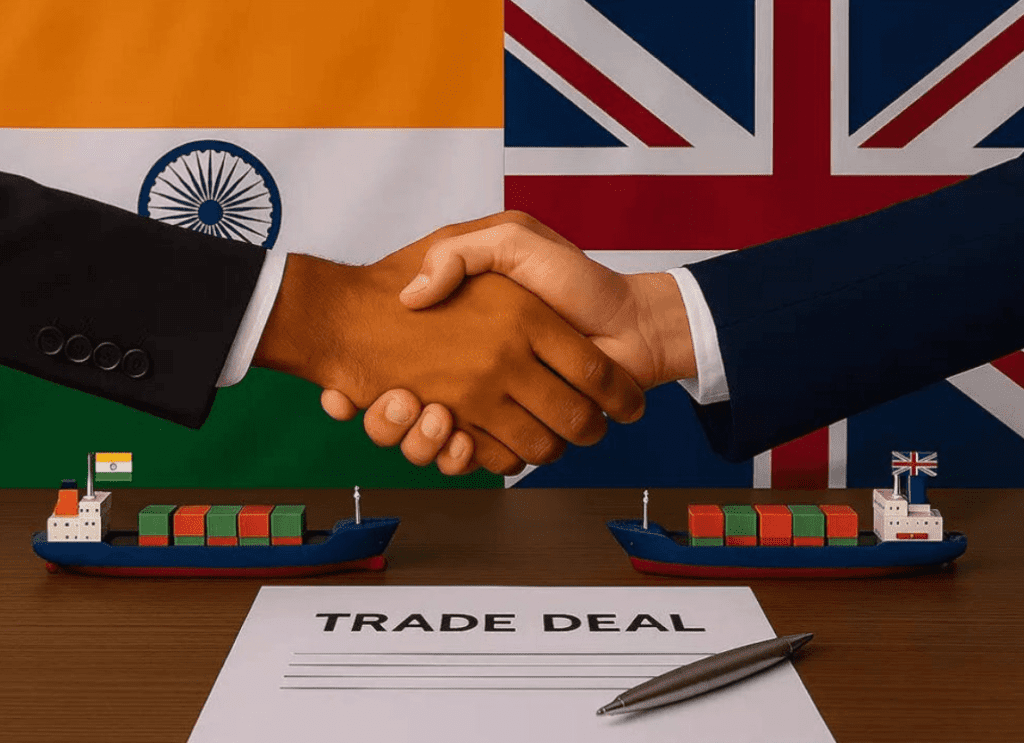The recently inked UK-India trade deal has gained attention for its potential to reshape economic ties between the two nations. At its core, the agreement aims to dismantle trade barriers, primarily through tariff reductions. For UK consumers, this means the prospect of cheaper clothes, shoes, food, and jewelry. Meanwhile, India stands to benefit from significantly lower tariffs on a range of UK goods, including sought after items like whisky, medical devices, cosmetics, biscuits, and luxury cars.
Read also: Strong US Economy & S. Korea Trade Deal: Why the Federal Reserve Should Cut Interest Rates Now
While the deal undoubtedly opens up new avenues for commerce, its overall impact warrants a measured assessment. The reduction of India’s “ridiculously high tariffs” on UK goods is a welcome step, potentially boosting UK exports and providing Indian consumers with access to higher quality products. However, the projected economic gains for the UK, with a GDP increase of just 0.13%, suggest that the deal hasn’t impacted economic growth as much as possible.
The UK-India trade deal has been promoted as a significant milestone in strengthening economic ties between the two nations. With the UK currently importing £11 billion worth of goods from India, the new agreement promises to lower tariffs and make Indian exports even more competitive. For UK exporters, the deal is set to reduce average tariffs from 15% to 3%, significantly easing the path for UK companies to sell their goods in the Indian market.
One of the most notable achievements of the deal is the reduction of India’s ridiculously high tariffs on whisky. While tariffs of up to 150% have long been a barrier, the UK has successfully negotiated a reduction to 75%, a major victory for British businesses. Moreover, these tariffs are slated to drop by another 40% by 2035, further enhancing the competitiveness of UK whisky in India.
The agreement also brings welcome news for UK car manufacturers, who will see tariffs slashed from110% to 10%. This reduction is poised to boost UK car exports to India, providing a significant boost to the UK automotive industry. While the overall economic impact of the deal may be modest, these specific tariff reductions represent tangible wins for key sectors of the UK economy.
The UK’s success in securing lower tariffs for its exports to India is undoubtedly a positive step. This agreement promises to make it easier for British exporters to access the Indian market, potentially boosting business and creating new opportunities. The projected addition of 2,000 jobs in the UK is also a welcome prospect, offering tangible benefits to the domestic economy.
However, while the deal represents progress, it’s crucial to acknowledge its limitations. In my view, the agreement doesn’t go far enough in addressing the full potential of the UK-India trade relationship. While the tariff reductions are significant, there may be other non-tariff barriers and regulatory hurdles that still impede trade and investment between the two countries.
To fully realise the benefits of closer economic ties, future negotiations should focus on a more comprehensive approach. This could include addressing issues such as intellectual property protection, regulatory alignment, and mutual recognition of standards.
The UK government projects that the trade deal with India will increase GDP by 0.13%, equivalent to £4.8 billion. While this deal opens up Indian markets and is expected to boost UK exports to India by 60% (£15.7 billion) and increase Indian imports to the UK by 25% (£9.8 billion) in the long run, the GDP impact appears modest. The estimated 0.19% increase in real wages for UK workers, equivalent to £2.2 billion, also suggests limited benefits for the workforce.
Although these numbers are positive, the overall impact on the UK economy seems relatively small in my opinion. The deal’s potential to significantly improve the financial well being of UK workers may be less than initially hoped. While it is better to have a deal than no deal, especially given the Conservative Party’s efforts to secure it, this agreement may not be the most advantageous outcome.
I generally support free trade and reciprocal agreements, but this particular deal appears to be a relatively small win for the UK. While I commend the Prime Minister for finalising the agreement, its impact on GDP and economic growth seems limited. My understanding is that this trade deal primarily focuses on reducing tariffs to provide British businesses with greater access to Indian markets. If the primary goal were significant economic growth, the UK government would have likely pursued a more impactful agreement.
The numbers associated with this deal do not suggest substantial economic gains. I’m not trying to diminish its importance, but considering the UK’s unemployment rate of 4.7% (1.2 million people), the projected creation of only 2,000 jobs will not have a significant impact.
Securing a trade deal is always preferable to having no deal at all. Congratulations to our government for finalising this agreement. India is projected to become the world’s third-largest economy by 2030, according to the World Economic Outlook. This deal provides the UK with valuable access to the Indian market, positioning us to benefit from its growth.

